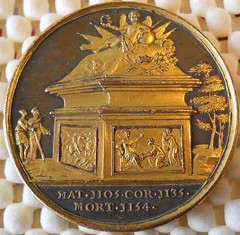
PREV ARTICLE
NEXT ARTICLE
FULL ISSUE
PREV FULL ISSUE
NUMISMATIC VOCABULARY: DAMASCENE
Dick Johnson submitted these thoughts on a medal, a numismatic vocabulary word, and the never-ending process of learning in numismatics. Thanks!
-Editor
My local coin dealer and good friend, Dick Bacca (Heads & Tails Coin Shop, Torrington) sent me a scan this week. "Help identify this medal" he emailed.


After some heavy researching the books I identified the medal from the Kings and Queens of England series, engraved by Jean Dassier. It is goldplating on a bronze medal, bears a portrait of King Stephen in full armor, with his vita in the reverse exergue: born 1105, crowned 1135, died 1154. Digging deeper I found Chris Eimer's comments on this series in his book "British Commemorative Medals" (page 79). Chris stated "Bronze medals are occasionally found damascened, whereby the relief is gilt and the field "bronzed." I vaguely remembered hearing the term damascene applied to medals before, but had never encountered an actual specimen. Here was an illustration in full color, and a documented use of the term "damascene." In metalworking damascene means an inlay of gold usually in steel. In the medallic field it is an imitation of this by goldplating. Dassier's series was first struck in 1731 but the dies still existed into the following century when the medals were restruck -- 34 in all -- and finished with a heavy bronzing treatment. After which the medals were masked off where the gold was not to be deposited leaving the dark bronze finish intact, then goldplated. After the masking was removed the medal exhibited the dark brown field in stark contrast to the bright gold relief. Since goldplating was not in active use until the 1840s, the restriking must have occurred after this time.(Before this time a gold surface was applied by firegilding with the use of mercury but the mercury fumes were poisonous, shortening the lives of such workers.) This piece was not firegilded, it was heavy goldplate. With an example of damascene in front of me I realized I had not included the term in my "Encyclopedia of Coin and Medal Technology." Trouble is, I had just sent off the full manuscript to my associate at Medallic Art Company, Rob Vugteveen, which had clocked in at 1,851 terms. I could now write the entry on damascene and be able to illustrate it. Clock in entry number 1,852. Hey, the book is not printed yet, I can still add another term.
I am in my seventh decade in numismatics, 71 of my 80 years. This is a textbook case: You are never too old to learn something new!
The Numismatic Bibliomania Society is a non-profit organization promoting numismatic literature. See our web site at coinbooks.org. To submit items for publication in The E-Sylum, write to the Editor at this address: whomren@gmail.com To subscribe go to: https://my.binhost.com/lists/listinfo/esylum All Rights Reserved. NBS Home Page Contact the NBS webmaster 
|